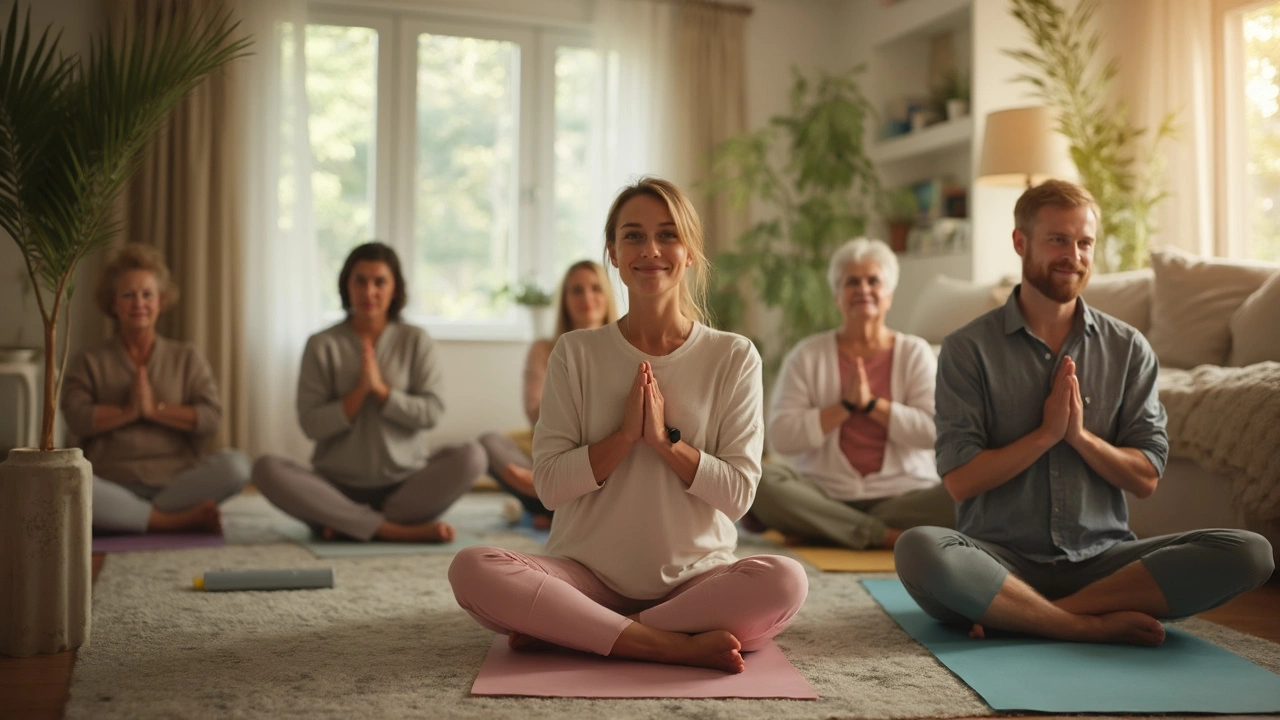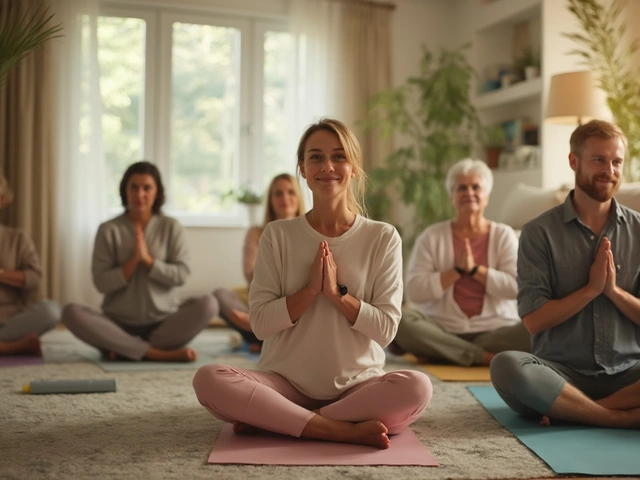Imagine waking up every morning without worrying about your next asthma attack. Sounds far-fetched? For thousands of folks juggling asthma every day, that kind of peace sounds priceless. But here’s the wild part: something as simple as yoga—yeah, stretching, breathing, being mindful—might help make it a reality. Turns out, some doctors suggest that rolling out a yoga mat actually does more than just chill your mind. Let’s get into how yoga works its magic on asthma and how you can use it to catch your breath, literally.
The Science Behind Yoga and Asthma
Let’s face it—everyone wants proof before trying something new, especially with asthma. The last thing you want is a trendy fad that fizzles out or, worse, triggers symptoms. So, what’s the case for yoga helping with asthma? It starts with how asthma attacks work: your airways get inflamed, they spasm, and suddenly, every breath feels impossible. Yoga steps in by calming that overreactive system. Several clinical studies back this up. In a 2024 review published in the Journal of Asthma, a team analyzed 12 different clinical trials—participants practicing yoga reported fewer attacks, better lung function, and less need for rescue inhalers.
Why does this happen? Most yoga routines center around controlled, deep breathing (called pranayama). When people breathe deeply and purposefully, their airways don’t tighten up so fast. On top of that, yoga encourages relaxation through movement and meditation, slashing your body’s stress levels. And stress? It’s a nightmare for anyone with asthma since anxiety can trigger attacks or make symptoms worse.
One cool fact: a 2021 study from the University of Manchester compared folks who did yoga three times a week to a control group. After just two months, the yoga group had a 30% lower rate of asthma attacks. Researchers were stunned at how yoga’s breathing techniques actually changed how the lungs responded to allergens and irritants—almost like teaching your airways not to panic at the first sign of trouble.
Beyond the research, real-life stories help too. Asthma support groups are buzzing with people sharing how gentle yoga routines, paired with medication, changed the game for them. Some even talk about having fewer hospital visits—though you should never toss your inhaler just because you took a few yoga classes. Still, with so much stacked up evidence, it’s worth asking your doctor about adding yoga to your asthma toolkit.
Breathing Techniques: Your Secret Weapon
If you’ve ever had an asthma attack, you know the panic that sets in when you can’t get enough air. Yoga’s biggest gift isn’t the poses—it’s the breathing tricks. Controlled breathing teaches your body to stay calm, slows your heart rate, and helps fight off the suffocating feeling that comes with an attack. You don’t need to know Sanskrit or turn yourself into a pretzel either; simple methods do the work.
Let’s start with belly breathing (also called diaphragmatic breathing). Lie on your back with one hand on your belly and one on your chest. Breathe in slowly through your nose and feel your belly rise. Exhale with your lips pursed, feeling your belly sink. Repeat for a few minutes. This style moves air deeper into your lungs, instead of shallow breathing which asthma often triggers. Here’s the kicker—this small trick actually lowers your respiratory rate and makes each breath more efficient.
Next up is alternate nostril breathing (Nadi Shodhana). Sounds fancy, but it’s just pinching one nostril, inhaling, then switching and exhaling through the other. This method is practically relaxation in a bottle. Try it for a minute or two and see how you feel—most people notice calm, steady breaths and less tension in their chest. The reason this works? It balances the nervous system, which usually freaks out during an asthma attack.
If you’re worried about trying these for the first time, keep your rescue inhaler nearby and never push too hard. Start slow, maybe 30 seconds at a time, and work your way up. Consistency is key here; the more you practice, the more your lungs adapt. Breathing exercises aren’t a magic cure, but they act like a training program for your respiratory system: the more you use it, the stronger it gets, and the less likely you are to spiral into panic during an asthma flare.
Many yoga teachers now offer ‘yoga for asthma’ classes (both online and in person), showing these breathing exercises step by step. If you’re shy or prefer privacy, plenty of free YouTube tutorials break it all down, complete with visuals and progressions for beginners.

Yoga Poses: Gentle Moves for Easier Breathing
Most people hear ‘yoga’ and picture headstands, twisted limbs, or sweaty power classes. Not necessary. When it comes to asthma, it’s the calm, restorative poses that pack the biggest punch. These moves open the chest, relax tight muscles, and support deep breathing—all things people with asthma desperately need.
Here’s a list of poses that asthma experts and yoga therapists recommend:
- Bridge Pose (Setu Bandhasana): Lie on your back, feet flat on the floor, knees bent. Press your feet into the floor and lift your hips, creating space in your chest. This opens up airways and encourages full, deep breaths.
- Child’s Pose (Balasana): Kneel with your forehead on the mat and arms by your sides. This pose relaxes the back, neck, and chest, allowing you to focus purely on your breath.
- Cobra Pose (Bhujangasana): Lie face down and slowly lift your chest using your hands. Perfect for expanding the chest and increasing lung capacity.
- Cat-Cow Stretch (Marjaryasana-Bitilasana): On your hands and knees, alternate arching and dipping your back. These poses gently stretch and strengthen the lungs and airways.
- Seated Forward Bend (Paschimottanasana): Sit with your legs straight, reaching for your toes. This calm pose invites slow, easy breathing.
If you want to build a routine, try holding each pose for 5–7 breaths, then rest in Child’s Pose. Always listen to your body—your goal isn’t to compete, but to create space for the breath. Modify as needed, and if you ever feel dizzy or get chest tightness, ease off and rest.
Yoga instructors often use props like bolsters, blankets, or blocks for support—totally worth it, especially if stiffness is an issue. If you can get to a certified yoga therapist, great, but don’t stress if you’re working with free videos at home. Even a few gentle poses after a rough day can prevent chest tightness from building up.
Another pro tip: Do yoga when you’re at your best, not when symptoms are flaring. Mornings are often a sweet spot—your lungs are clearer and air quality is usually best. And skip any class or pose that pushes you to hold your breath for too long or strains your chest; asthma yoga is about smooth, easy breathing, not high effort.
Building Yoga into Your Asthma Routine
Sticking with something new is tough, especially when you’re juggling daily meds, doctor visits, and life’s regular chaos. But working yoga into your asthma routine doesn’t have to feel like a massive job. Instead of signing up for a fancy class, most people start with 10–15 minutes at home a few times a week. Pick your favorite poses or breathing exercises, set a timer, and cut yourself some slack—progress, not perfection, is the goal.
One practical tip: keep your inhaler nearby, and let someone in your household know you’re starting something new, just in case. If you use a peak flow meter to track your asthma, jot down your numbers before and after yoga for a couple of weeks. Some folks notice steady improvements—bonus motivation to stick with it.
Many asthma specialists actually encourage their patients to combine yoga with their existing treatment plan, not use it instead. So, keep taking your medication as prescribed. Think of yoga as another tool in your toolbox, along with humidity monitors, allergen-proof bedding, and quick access to an inhaler.
If you prefer a social vibe, check out group classes. Community centers and YMCAs often offer gentle yoga for people with chronic illnesses—sometimes even free. You might meet others in the same boat, share tips, and swap progress stories. The support can make sticking with yoga (and healthy routines) a lot easier.
Finally, don’t get discouraged if it takes a while to notice big changes. Just like any skill, yoga’s benefits build up over weeks. That said, most people report feeling relaxed and less tense even after the first session. And that’s not nothing, considering how stress feeds into asthma flare-ups. Treat yoga like brushing your teeth—a daily (or almost daily) habit that quietly keeps trouble at bay.






Anoop Choradia
July 18, 2025 AT 17:05It is, undeniably, a fascinating premise to consider that yoga could serve as a mechanism to alleviate symptoms of asthma, a condition that has traditionally been managed through pharmacological interventions. Unfortunately, while yoga's benefits on respiratory function are often touted, I remain skeptical without rigorous, peer-reviewed clinical trials delineating these effects with precision. One must ask if the purported decrease in asthma attacks is more correlated with placebo effects or if specific yoga breathing techniques truly induce substantive physiological changes.
Moreover, the article's approach to making yoga accessible for beginners, especially those with asthma, is laudable, yet insufficiently detailed. What exact postures or pranayama methods are recommended? And how can these be safely integrated into the daily routine of individuals who might tolerate physical exertion poorly? The article could benefit from a more comprehensive inclusion of safety protocols and contraindications specific to asthma sufferers.
Lastly, it is imperative that any non-traditional therapy like yoga is regarded as complementary rather than substitutive to conventional medical treatments. Rigorous monitoring and consultation with healthcare professionals must remain paramount to avoid adverse outcomes.
bhavani pitta
July 19, 2025 AT 12:05Honestly, while yoga is certainly trendy and seen as some sort of cure-all, I can’t help but roll my eyes a bit at the idea that it’s a genuine fix for asthma attacks. Sure, stretching and breathing exercises might feel calming, but equating these to actual symptom management feels a little overdramatic. Like, don’t people just want quick fixes instead of dealing with what asthma actually is?
Also, the article glosses over the complexity of asthma itself. It’s not just about taking deep breaths; it’s a chronic lung condition with serious triggers that yoga can’t simply erase. So, I’m not really sold on the idea that yoga will drastically reduce attacks for everyone. And what about those who can’t afford fancy yoga classes or don’t have the time to regularly practice? Seems a bit idealistic to me.
But hey, I’m open to seeing some concrete evidence before jumping on the bandwagon.
Brenda Taylor
July 20, 2025 AT 12:05lol, some people just gotta make everything complicated. 🙄 Yoga is super chill and honestly, even if it’s just stretching and breathing, that stuff helps me breathe better when I’m feeling tight. I’ve had asthma since I was a kid and doing simple yoga routines has helped cut down on my panic attacks during flare-ups.
Plus the extra calm? That’s a game changer. Sure, I’m not a scientist, but if it works for me, why not try it? Sometimes you just gotta relax your body and mind, and this article hits that note perfectly. I’m all for anyone who needs to breathe easier giving this a shot. 😊
Taryn Thompson
July 21, 2025 AT 15:13From a healthcare perspective, I can affirm that incorporating yoga, particularly focused breathing exercises like pranayama, can be an excellent adjunct to traditional asthma management. Obviously, patients should continue prescribed medications but yoga can enhance overall lung capacity and reduce stress, which often precipitates attacks.
The article rightly points out that even beginners can start gently, without vigorous poses that might exacerbate symptoms. I recommend patients start with guided classes and clear instructions to avoid hyperventilation or dizziness.
One must emphasize this is not a stand-alone cure but part of holistic management. The psychological benefits alone often encourage adherence to treatment and lifestyle changes.
Paul Hill II
July 24, 2025 AT 14:51I appreciate the perspective that yoga can support asthma sufferers by promoting better breathing techniques. It’s refreshing to see wellness modalities recognized alongside traditional medicine.
However, I’m curious how sustainable the benefits are over the long term. Does the article specify the frequency and duration of yoga practice needed for noticeable improvements? And how does it address potential variability across different asthma severities?
Also, it would be interesting to hear user testimonials or clinical data reinforcing these claims.
Stephanie Colony
July 26, 2025 AT 08:31This whole idea reeks of another overhyped wellness fad. Yoga drama is just another means for privileged elites to pretend they’re curing themselves without real medicine. Who has the time or the fancy classes to just breathe their way out of asthma?
Asthma is a serious condition demanding concrete medical intervention, not just some flowery posture and chanting nonsense. I find the article absolutely superficial and dangerously misleading if people start favoring yoga over proven pharmaceuticals.
Let’s face it, this is the latest tier of health snake oil, dressed up as holistic healing for gullible masses.
Abigail Lynch
July 30, 2025 AT 15:18Am I the only one who feels like these 'natural strategies' are just a way to cover up the pharmaceutical industry's failure? I mean, do we really trust these yoga poses more than the medicines prescribed? It makes me wonder if this is all just part of some grand conspiracy to get us to invest time in useless practices so Big Pharma profits more...
That said, I've tried yoga before, and while it calmed me down, my asthma attacks didn't really reduce in frequency. Maybe it's just wishful thinking.
David McClone
August 2, 2025 AT 07:11Oh great, now we’re supposed to believe some downward dog will stomp out asthma. Seriously though, the article’s breathy enthusiasm aside, I’d be interested in seeing some robust scientific evidence rather than anecdotes. Breathing better is crucial for asthma, yes, but is yoga really the magic wand people pimp it as?
Also, I can’t help but laugh at the idea that one can just 'discover proven techniques' so effortlessly if you're a total beginner. It’s probably way harder for real folks struggling daily to manage their condition to just 'fit yoga in' without exacerbating symptoms or wasting time.
Jessica Romero
August 10, 2025 AT 09:38I find this topic quite intriguing, especially from a multidisciplinary standpoint involving respiratory therapy and holistic wellness. Yoga, specifically sequences emphasizing controlled breathing and relaxation, can indeed contribute positively to pulmonary function by promoting diaphragmatic breathing patterns and reducing hyperventilation episodes.
However, it is imperative for practitioners and patients alike to recognize the importance of individualized assessment. Not all yoga postures are beneficial; some pranayama techniques may need modification to accommodate bronchial sensitivities.
Educational resources that clearly delineate appropriate techniques for asthma management can empower patients to engage safely and effectively.
Michele Radford
August 14, 2025 AT 22:33While I appreciate the promotion of natural therapies, I remain inherently skeptical about the efficacy of yoga in substantially reducing asthma attacks. There appears to be a lack of comprehensive clinical trial data supporting such claims, potentially misleading patients into deprioritizing pharmacological treatment.
It might be prudent for patients to consider yoga as a supplementary measure rather than a primary intervention. The article’s optimistic tone, without adequately highlighting these limitations, risks fostering a dangerous false sense of security.
Mangal DUTT Sharma
August 17, 2025 AT 16:36As someone living with asthma and having experimented with yoga, I can say it definitely helps me in many ways. The coolest part is how it teaches you to control your breath consciously, which is super useful during flare-ups. 😊
At first, it was hard to stay motivated, especially on days when I felt breathless. But over time, I noticed less coughing and fewer wheezy nights. It’s not a magic cure though; meds and doctor advice still very much rock.
What I love is how yoga also helps me chill mentally, reducing stress that often triggers my asthma. For anyone struggling, I’d say definitely give it a try, start slow, and listen to your body. 👍